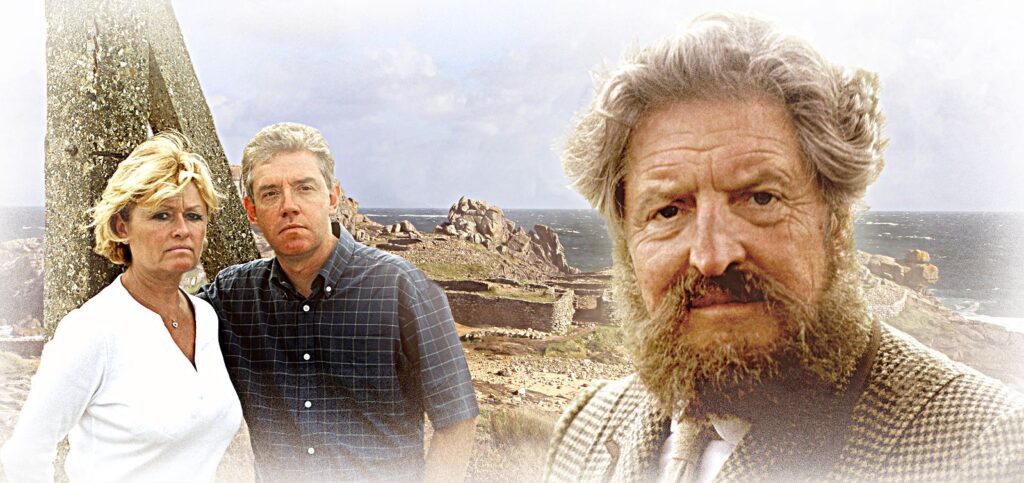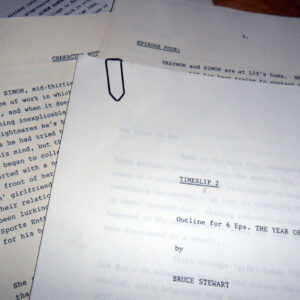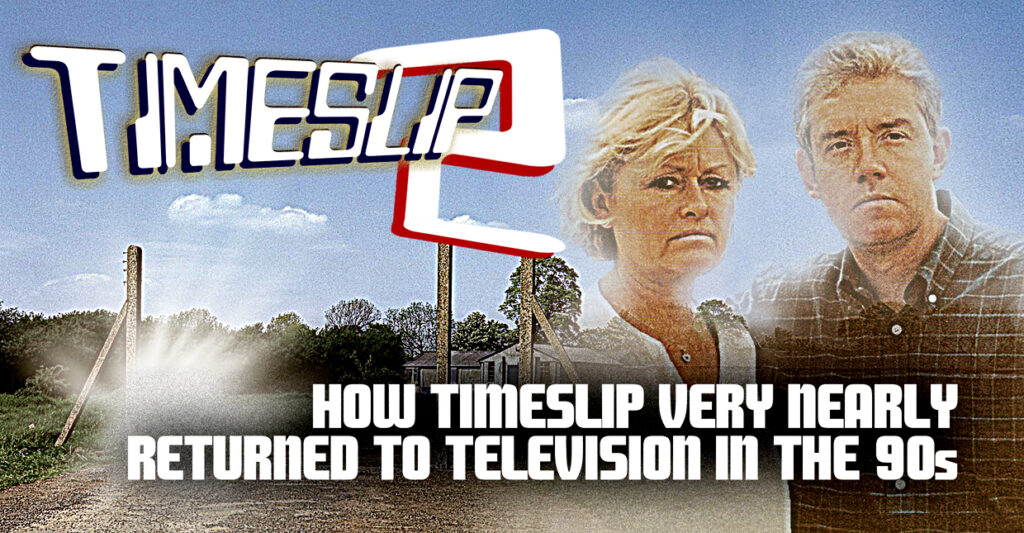
SIDEWAYS IN TIME – The Timeslip Sequel That Never Was
The following feature appeared in the July 2020 edition of SFX magazine. It has been amended slightly to bring it up to date.
The innovative 26-part science fiction series Timeslip was first shown on ITV from September 1970 to March 1971. It made a lasting impact on its audience and was repeated in 1973 – ’74.
Its four linked multi-episode storylines included: an attempt to uncover the whole truth about a secret project 30 years back in the Second World War; human cloning; a faulty lifespan longevity drug with a terrible impact; and future scientific manipulation of the climate which runs out of control (in the eight-part adventure The Year Of The Burn Up). The show may have been short-lived, but it was remembered fondly.
The only further adventures for teenage time travellers Liz and Simon came in the comic-strip in Look-in – “the junior TV Times” – in the early 1970s, initially with artwork by one of the favourites of comics fans, Mike Noble, who already had Gerry Anderson strips such as Captain Scarlet and Zero X under his belt from his days on TV21. But had time slipped another way, there could have been up to 13 further episodes of the show – and who knows what else…
A magazine piece in 1990 revealed that Victor Pemberton, one of the series’ writers, had obtained the rights to make a new series from ITC – something he confirmed in person at a Cult TV weekend in 1994. He and his fellow writer from the show Bruce Stewart had indeed devised
new outlines. But as time slipped away, the project failed to materialise and details became sketchy.
Steve Hardy, who set up the original official website for the series in early 2003 and its successor version, recalled that Pemberton had brought Stewart – who wrote the first 19 episodes of the original – on board. Together, they tried to get a sequel off the ground through
Pemberton’s company Saffron Productions Ltd in conjunction with UK production company Zenith. Pemberton and Stewart, it turned out, came up with a couple of storylines to pitch to potential broadcasters. “The trouble was,” said Hardy, “in the intervening years, the paperwork had got lost.”
“When I asked Victor about it, some 15 or so years ago now, he suggested I contact Bruce. When I approached Bruce, he said I should ask Victor…” Pemberton and Stewart, both now dead, each claimed they no longer had any of the documentation and neither of them could recall any important points about the plots. The breakthrough in finding out details came in March 2020 when a member of the Timeslip Facebook page tipped off Hardy about an auction of paperwork for an aborted TV sequel. Hardy decided to obtain it for the group P.A.S.T. Projects which has acted as a focus for Timeslip fandom.
He persuaded the vendor to shut down the eBay auction and negotiate the sale privately to P.A.S.T. Projects. The vendor was, in fact, handling the disposal of Victor Pemberton’s archive with the result that “quite a few” items thought to be lost had come to light, sparking Hardy’s curiosity that other items of interest might crop up. Hardy purchased the Timeslip material along with other items that did indeed prove of interest. There was documentation on Victor’s series Tightrope – a 13-part 1972 children’s thriller starring Spencer Banks (ex-Timeslip) and John Savident – and Pemberton’s personal scrapbook containing newspaper and magazine clippings documenting his career, especially his 1968 Doctor Who story Fury From The Deep, still missing from TV archives.
 “The documentation itself is fascinating and acts as a roadmap of the sequel’s development,” said Hardy. “There are story outlines, proposals, character profiles, correspondence with various potential co-producers of the series and even correspondence with Stephen Hawking’s agent as part of Saffron’s attempt to secure Professor Hawking as the series’ technical adviser!” (The scientific adviser for the original show was Geoffrey Hoyle, son of the distinguished astronomer Fred Hoyle.)
“The documentation itself is fascinating and acts as a roadmap of the sequel’s development,” said Hardy. “There are story outlines, proposals, character profiles, correspondence with various potential co-producers of the series and even correspondence with Stephen Hawking’s agent as part of Saffron’s attempt to secure Professor Hawking as the series’ technical adviser!” (The scientific adviser for the original show was Geoffrey Hoyle, son of the distinguished astronomer Fred Hoyle.)
Pemberton proposed a storyline, Return To The Time Barrier, which consisted of six half-hour episodes. In it, Liz and Simon are now in their early 30s. Their apparently chance meeting after many years has been manipulated. They again experience timeslips, prompting Simon to seek out Commander Traynor, the ambiguous figure from the original stories, now a recluse living on an otherwise uninhabited island. Simon and Traynor are puzzled as to why the barrier is active again; then Liz’s daughter disappears and it becomes apparent that the barrier was reactivated to use Liz and Simon for some purpose.
A timeslip resulting in Simon meeting a descendant of his precedes the reappearance of the menacing clone version of Traynor from the original show. The clone now plans to destabilise the way time functions in a bid for supreme power. Pemberton’s outline touches on a grand theme of how sections of the universe seem to act like a giant computer, even down to the possible evolution of the human race, and that without the right software, the results can be menacing.
Another outline, by Stewart, entitled Timeslip 2: The Year Of The Time Bomb, presents a friendly but mysterious new character. He is misguided rather than evil in his plan to collect prominent characters from history to help guide the human race away from its path of destruction through pollution and over-exploitation of resources. The theme echoes ideas raised in Stewart’s original Burn Up story (which Pemberton wrapped up in its last episode) of environmental concerns predicting, in 1970 – ’71, what has been referred to as climate change or global warming.
The new story of course involves Liz and Simon, again as adults, as well as Liz’s daughter Hannah, and Commander Traynor who Simon encounters in a future projection. This time Traynor is involved with a group fighting an industrial corporation engaged in the secret and
illegal disposal of toxic waste. Bruce Stewart drastically rewrote this outline, basing his second version around a conflict between the real Traynor – who Simon finds hiding away on an island and who refuses until late in the story to confront his evil clone double – and his clone who turns out to be the villain.
Other papers in the acquisition include a letter of agreement, dated April 1990, between Stewart and Pemberton’s company Saffron that Stewart should write a sequel outline for £100; and correspondence from Spencer Banks – who originally played Simon – to Pemberton, including Banks’s comments on the new work. Banks notes that the introduction of the historical characters reminds him of Terry Gilliam’s comic fantasy film Time Bandits (1981), though he concedes that the new work is “imaginative and there are some extremely good things”.
“There was always strong credible drama,” Spencer writes of the original series in one letter, adding: “The principle of the time barrier was unique (no super sci-fi machinery, exotic light effects), it was simple and sinister.” Banks posits that the often antagonistic brother-sister side of Liz and Simon’s relationship is why the chemistry between them really works, drawing comparisons to the ‘80s US private eye series Moonlighting which starred Bruce Willis and Cybill Shepherd – “though without the glitz and the implied sex!”
He praises some developments such as Hannah, Liz’s daughter, but queries how the motives of the malevolent forces are portrayed, saying: “If the story follows the line of profit at all cost then the issues should be in realistic context. Individuals bent on world domination are for Bond films – need to be outrageous to work and the story equally so.”
A 1993 letter from Dawn Airey, controller of Children’s & Daytime Programmes at the ITV Network Centre, to Victor Pemberton’s project partners Zenith warns: “TIMESLIP would go into the Autumn ’95/Winter ’96 offers, and although I am enthusiastic about the project a significant number of additional proposals will inevitably be received in the next 12 months that will also compete for these slots. So knowing the chances of a commission are slim, but with the knowledge I was a fan of the series, I will leave it up to you as to whether or not Zenith South will invest in the development of this series. I hope you do!”
Sadly, it wasn’t to be, with subsequent papers revealing letters showing Pemberton’s frustration at getting no positive responses to a proposed sequel. This was despite proposed involvement from ITC suggesting that it would require at least 13 episodes to secure American co-funding. And though a TV follow-up may not have arrived, a small though loyal number of fans kept the flame burning over the years.
P.A.S.T. Projects organised several events for the show’s followers including a mini-convention in 2007 in Cuffley, Hertfordshire, close to the time barrier location site. Series creator and script editor Ruth Boswell and stars Cheryl Burfield and Spencer Banks were among the guests happily sharing their memories of the show with the fans. There was also the launch in 2009 of the 93-minute making of… documentary Behind The Barrier at the Rex Cinema in Berkhamsted, Hertfordshire, and a 40th anniversary celebration of the series back in Cuffley in 2010, with Ruth, Cheryl and Spencer again joining other guests from the show for these landmark celebrations.
Chris Gibbings

